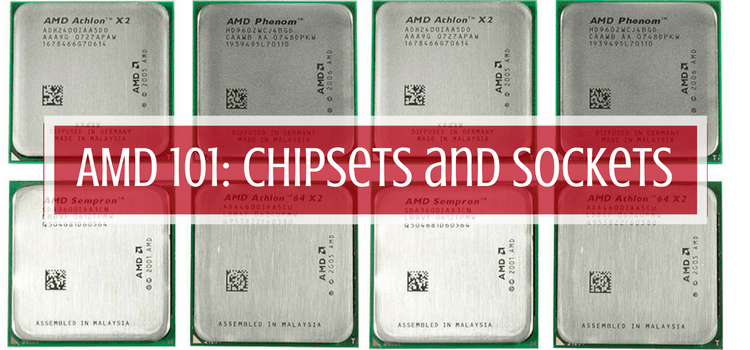Whenever you purchase a computer, deciding which CPU it has is often a very big consideration. What many people forget about, especially in desktops, is the motherboard capabilities that could limit your CPUs performance. This leads to the introduction of the Chipset and Socket for your motherboard. Both of these key components require some consideration, but many people are swamped with the abundance of knowledge from everyone. Here, we have broken it down for you to help you learn the basics and help you make that ultimate CPU decision.
CPU vs. Chipset vs. Socket
Really quick, let’s recap what each of these components are and what they do. The chipset and socket are located on the motherboard of your computer. A chipset is similar to the subconscious of the brain. You don’t really see it because it is underneath the socket, and it handles communication between computer components like the CPU to the rest of the motherboard. The socket is the pin grid array (PGA) that the CPU plugs into. It is essentially the female end of a plug. The CPU is the central processing unit, and is the final piece of the puzzle. It is responsible for your computer being able to actually do its job. All three of these pieces have to work in conjunction with each other in order to work efficiently.
When you are purchasing a CPU, you HAVE to pay attention to what kind of chipset and socket that your motherboard has. The chipset will dictate which CPU the motherboard can take, and so will the socket. If the CPU you purchase is not compatible with the socket, you will not be able to correctly install the CPU onto your motherboard.
AMD Sockets
At the time of writing this, AMD has 3 sockets available on the market that work with current CPUs. Each of these sockets have different configurations for pins, and can handle different CPUs and APUs. Knowing some of the differences of these sockets will help to determine which kind of CPU you are looking for, and which ones you aren’t. Below are the sockets that support current marketed CPUs, and a little bit about them.
| Socket | CPUs Supported | # of Pins | Benefits |
| AM3+ | AM3 Processors; Bulldozer architecture | 942 | Improved power regulation; Handles faster processors |
| FM2+ | Kaveri APUs; Steamroller architecture | 906 | Supports APU units; On-die GPU |
| AM1 | Athlon and Sempron APUs | 721 | Extremely Budget Friendly |
AMD Chipsets
Although the socket is important in determining which CPU to buy, the chipset is equally pertinent. Since it is the subconscious, poorly selecting a chipset could limit the processing power of your computer, which would be a waste of money. A chipset has two main components to it, a Northbridge and a Southbridge. The Northbridge deals with the interfaces that require the greatest performance (RAM, PCI-E, CPU, etc.). The Southbridge handles more of the slower interfaces such as the USB, BIOS, and PCI. Over the last few generations, AMD has integrated the CPU die with some of the Northbridge functions.
AMD has two series of Chipsets on the market right now, the A-Series, and the 9-Series. The A-Series is designed more for APU’s, whereas the 9-Series is a step above the average for normal CPUs.
The A-Series:
These are the specs from the A-Series line up. The A85X, A75, and A55 fall under the FM2 sockets (an older version of the FM2+). The other four fall under the FM2+ socket.
14 (4)14 (4)14 (0)14 (4)14 (4)10 (2)14 (0)
| CHIPSET BRAND | A85X | A75 | A55 | A88X | A78 | A68H | A58 |
| PCI EXPRESS® | 1×16 / 2×8 | 1×16 | 1×16 | 1×16 / 2×8 | 1×16 | 1×16 | 1×16 |
| SATA III | 8 (8) | 6 (6) | 6 (0) | 8 (8) | 6 (6) | 4 (4) | 6 (0) |
| RAID | 0, 1, 5, 10 | 0, 1, 10 | 0, 1, 10 | 0, 1, 5, 10 | 0, 1, 10 | 0, 1, 10 | 0, 1, 10 |
| RAID DRIVER | Promise | Promise | Promise | Dot Hill | Dot Hill | Dot Hill | Dot Hill |
The 9-Series:
These are the 9-Series Graphics Cards. There are only four available, but they offer some of newest technologies for your PC experience.
| 990FX Chipset | 990X Chipset | 980G Chipset | 970 Chipset | ||
| GRAPHICS | Not Included Up to 4 slots for Graphics Upgrade | Not Included Up to 2 slots for Graphics Upgrade | ATI Radeon™ HD 4250 Support for DirectX 10.1 1 slot for Graphics Upgrade | Not Included One slot for Graphics Upgrade | |
| CPU COMPATIBILITY | AMD Athlon™ II, AMD Phenom™ II, AMD FX | AMD Athlon™ II, AMD Phenom™ II, AMD FX | AMD Athlon™ II, AMD Phenom™ II, AMD FX | AMD Athlon™ II, AMD Phenom™ II, AMD FX | |
| MEMORY SUPPORT | AM3+ socket motherboards support DDR3 | AM3+ socket motherboards support DDR3 | AM3+ socket motherboards support DDR3 | AM3+ socket motherboards support DDR3 | |
| PCI EXPRESS® | PCI Express® 2.0 | PCI Express® 2.0 | PCI Express® 2.0 | PCI Express® 2.0 | |
| USB | Up to 14 USB 2.0 | Up to 14 USB 2.0 | Up to 14 USB 2.0 | Up to 14 USB 2.0 | |
| SATA | Supports SATA 6Gb/s devices | Supports SATA 6Gb/s devices | Supports SATA 6Gb/s devices | ||
AMD has long been in the CPU race, and it realized the importance of maintaining up to date corresponding hardware. Now equipped with this basic knowledge of AMD’s chipsets and sockets, you can go forth and choose your CPU responsibly.
